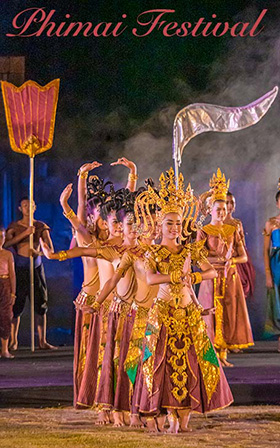


|
It is perhaps not well known that there are several Khmer temples in Thailand. One of the most accessible, with a high level of restoration, is Prasat Hin Phimai, in the Isaan town of Phimai. The Phimai Historical Park, set up to protect Prasat Hin Phimai, is located in the center of town. Built as a Brahmin temple dedicated to Shiva in the reign of Suryavaraman I (1006-50), it was rededicated as a Mahayana Buddhist temple during the reign of Jayavarman VII (1181-1218). Every year in November, the Phimai Festival features a laser light show, boat races and local cuisine. |
Unlike most Khmer temples which are orientated in an east-west direction, Prasat Hin Phimai is orientated in a north-south direction. Why this is so is not clear as it is not the direction pointing to Angkor.
Like many Khmer temples, Prasat Hin Phimai is rectangular. The central prang, Prang Brahmathat, represents Mt Meru, center of the Hindu Universe. Four surrounding ponds, now empty, represent the four oceans.
Entering via a naga (mythical serpent) bridge I strode along a walkway which bought me to the sanctuary under the central prang. Doorways leading into the santuary were decorated by carved lintels featuring stories from the Ramayana. Inside, a statue of Jayavarman VII, sitting as Buddha is shaded by a naga. The symbolism is that the King and the Buddha are one, the same being. This statue is a replica. The original is housed in the Phimai National Museum.
A curosity on the walls of the temple was an etching of a mosquito. Whether it has significance or it just ancient graffiti, I had no idea. Anyone who knows something about it is invited to comment.
Outside, east of the temple, are many small standing Buddha images. I did not see this arrangement elsewhere in Thailand though it is common in Japan, for example the Mitaki-ji Temple in Hiroshima. Maybe it is an Mahayana Buddhism theme. Mahayana Buddhism was the form adopted by the Khmer rulers. This was later replaced by Theravada Buddhism which also dominates in Thailand.
Prasat Hin Phimai was the last in a series of temples connected to Angkor by an ancient road. Once thought to be straight, is now known to have zig-zagged to Prasat Hin Khao Phnom Rung and Prasat Ta Muean. Then the road left the Korat platuea and went down a 200 meter high scarp into todays Cambodia. Along its route were guest houses. Lighted torches allowed nightly navigation. King Jayavarman VII supplemented the guest houses with a series of hospitals.
Less than a kilometer from the temple is the Phimai National Museum. Amongst its exhibits are artifacts from the Isaan region, lintels from Prasat Hin Phimai and a statue of Jayavarman VII found in one of its prangs.
The advantage of lintels displayed in the museum is the close proximity from which they can be viewed. This is generally not possible when housed in their temple environment.
Every November the Phimai Festival is held. There are a number of activities including the provision of local cuisine, the Korat cat competition, dragon boat races, and the light, dance and singing performance presented at Brahmathat Court, Prasat Hin Phimai.
The dragon boat races are held in a specially prepared section of the Chakkarat River. Teams from all over Thailand come to compete.
My personal highlight of the Phimai Festival is the light, sound, singing and dance show. The story is set in the reign of Jayavarman VII. Though I suspect that historical accuracy is not a top priority. Not being able to follow the story line, as it was in Thai or maybe even an Isaan dialect, did not diminish my enjoyment.
There were four performances, from Thursday to Sunday, starting 7:30pm to 8:00pm and running for approximately 2 hours. On the preceding Wednesday night there was a free non-costume rehearsal.
The performance ends with the presentation of the Buddha. This Buddha statue was the one found in the temple and now housed in the museum.
After the show the audience is allowed into the court to mingle with the performers and take a few photographs.
I watched the performance over two nights, photographing and videoing on each. In retrospect that was probably not the best idea, I should have done photography on one night and video on another, especially as I knew I would be attending at least two performances. Both the slide show and video presented are a mixture from both nights.

It would be wrong to think of Phimai as a mini Siem Reap, the modern town near Angkor, Cambodia.
Most of Prasat Hin Phimai's 300,000/yr visitors are Thai.
Restaurants with non-Thai language menus are few. The multitude of tourist agencies offering more or less the same tours are absent. Even in this week, the week of the festival, foreign faces are only a tiny percentage of the total.
Phimai's economy revolves around servicing retail, agriculture and construction. It does have some industry, for example a shoe factory and salt factory.
Cultural and religious life is conducted in its five Buddhist wats.
The wiharns of the Isaan are much higher and narrower than their counterparts in the rest of Thailand. I haven't been inside of one as they always seemed to be closed when I am present. Getting inside of one is still on my to do list.